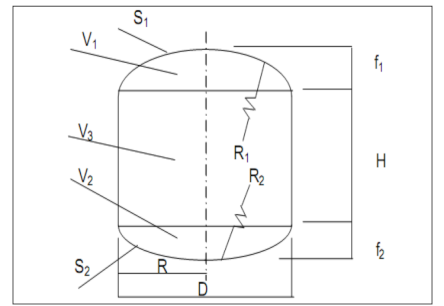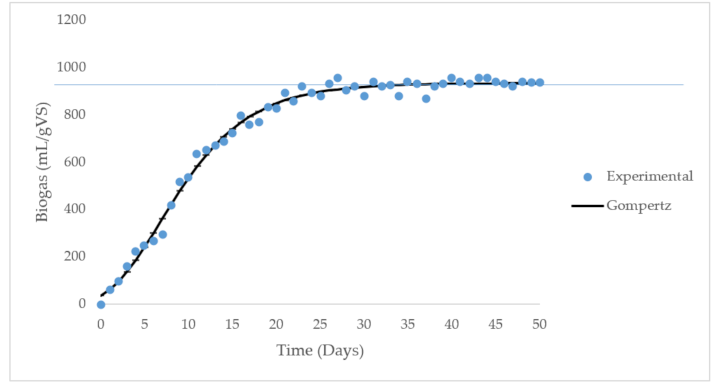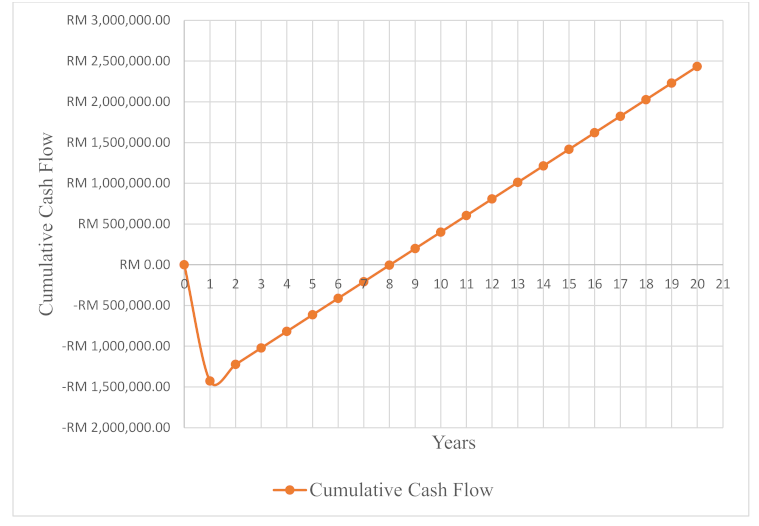Techno-Economic Assessment of On-Farm Anaerobic Digestion System Using Attached-Biofilm Reactor in the Dairy Industry
Abstract
1. Introduction
2. Materials and Methods
2.1. Collection of Cow Manure
2.2. Bioreactor Design Dimensions
2.3. Microbial Kinetic Studies
2.4. Economic Analysis
2.5. Computer Software
3. Results and Discussion
3.1. Characteristics of Cow Manure
3.2. Bioreactor Design
3.2.1. Relationship between the Flow Rate of Cow Manure and Volume of Bioreactor
3.2.2. Relationship between Rate of Cow Manure and HRT
3.2.3. Bioreactor Design
3.3. Microbial Kinetic Studies
3.4. Economic Studies
3.4.1. Electricity
3.4.2. Economic on Biogas Production
4. Conclusions
Author Contributions
Funding
Acknowledgments
Conflicts of Interest
References
- Akbulut, A. Techno-economic analysis of electricity and heat generation from the farm-scale biogas plant: Çiçekdaĝı case study. Energy 2012, 44, 381–390. [Google Scholar]
- Argun, H.; Gokfi, P.; Karapinar, I. Biohydrogen Production: Sustainability of Current Technology and Future Perspective; Springer: New Delhi, India, 2016. [Google Scholar]
- Bharathiraja, B.; Sudharsanaa, T.; Bharghavi, A.; Jayamuthunagai, J.; Praveenkumar, R. Biohydrogen and Biogas—An overview on feedstocks and enhancement process. Fuel 2016, 185, 810–828. [Google Scholar] [CrossRef]
- Chasnyk, O.; Sołowski, G.; Shkarupa, O. Historical, technical and economic aspects of biogas development: Case of Poland and Ukraine. Renew. Sustain. Energy Rev. 2015, 52, 227–239. [Google Scholar] [CrossRef]
- Cuéllar, A.D.; Webber, M.E. Cow power: The energy and emissions benefits of converting manure to biogas. Environ. Res. Lett. 2008, 3. [Google Scholar] [CrossRef]
- Gadhamshetty, V.; Arudchelvam, Y.; Nirmalakhandan, N.; Johnson, D.C. Modelling dark fermentation for biohydrogen production: ADM1-based model vs. Gompertz model. Int. J. Hydrog. Energy 2010, 35, 479–490. [Google Scholar]
- Das Ghatak, M.; Mahanta, P. Kinetic model development for biogas production from cattle dung. AIP Conf. Proc. 2017, 1859, 020010. [Google Scholar] [CrossRef]
- Jamali, N.S.; Jamaliah, J.M. Optimization of Thermophilic Biohydrogen Production by Microflora of Palm Oil Mill Effluent: Cell Attachment on Granular Activated Carbon as Support. Malays. J. Anal. Sci. 2016, 20, 1437–1446. [Google Scholar]
- Mainardis, M.; Flaibani, S.; Mazzolini, F.; Peressotti, A.; Goi, D. Techno-economic analysis of anaerobic digestion implementation in small Italian breweries and evaluation of biochar and granular activated carbon addition effect on methane yield. J. Environ. Chem. Eng. 2019, 7, 103184. [Google Scholar] [CrossRef]
- Jamali, N.S.; Jahim, J.M.; Isahak, W.N.R.W.; Abdul, P.M. Particle size variations of activated carbon on biofilm formation in thermophilic biohydrogen production from palm oil mill effluent. Energy Convers. Manag. 2017, 141, 354–366. [Google Scholar] [CrossRef]
- Urbaniec, K.; Bakker, R.R. Biomass residues as raw material for dark hydrogen fermentation—A review. Int. J. Hydrog. Energy 2015, 40, 3648–3658. [Google Scholar] [CrossRef]
- Li, Y.; Zhao, J.; Achinas, S.; Zhang, Z.; Krooneman, J.; Euverink, G.J.W. The biomethanation of cow manure in a continuous anaerobic digester can be boosted via a bioaugmentation culture containing Bathyarchaeota. Sci. Total Environ. 2020, 745, 141042. [Google Scholar] [CrossRef]
- Syakina, N.; Farahana, N.; Rashidi, D.; Jahim, J.; O-thong, S.; Jehlee, A.; Sakinah, N. Food and Bioproducts Processing Thermophilic biohydrogen production from palm oil mill effluent: Effect of immobilized cells on granular activated carbon in fluidized bed reactor. Food Bioprod. Process. 2019, 117, 231–240. [Google Scholar]
- Ruiz, D.; Miguel, G.S.; Corona, B.; Gaitero, A.; Domínguez, A. Environmental and economic analysis of power generation in a thermophilic biogas plant. Sci. Total Environ. 2018, 633, 1418–1428. [Google Scholar] [CrossRef]
- Xing, B.S.; Han, Y.; Wang, X.C.; Cao, S.; Wen, J.; Zhang, K. Acclimatization of anaerobic sludge with cow manure and realization of high-rate food waste digestion for biogas production. Bioresour. Technol. 2020, 315, 123830. [Google Scholar]
- Bergland, W.; Dinamarca, C.; Toradzadegan, M.; Nordgård, A.S.R.; Bakke, I.; Bakke, R. High rate manure supernatant digestion. Water Res. 2015, 76, 1–9. [Google Scholar] [CrossRef]
- Li, Y.; Zhao, J.; Krooneman, J.; Euverink, G.J.W. Strategies to boost anaerobic digestion performance of cow manure: Laboratory achievements and their full-scale application potential. Sci. Total Environ. 2021, 755, 142940. [Google Scholar] [CrossRef]
- Nazari, L.; Sarathy, S.; Santoro, D.; Ho, D.; Ray, M.; Xu, C.C. 3—Recent advances in energy recovery from wastewater sludge. In Direct Thermochemical Liquefaction for Energy Applications; Woodhead Publishing: London, UK, 2018. [Google Scholar]
- Bo, H. Biological Hydrogen Production via Self-Immobilized Bacteria. Ph.D. Thesis, Department of Biological Systems Engineering, Washington State University, Pullman, WA, USA, 2007. [Google Scholar]
- Jamali, N.S.; Jahim, J.M.; Isahak, W.N.R.B.W. Biofilm formation on granular activated carbon in xylose and glucose mixture for thermophilic biohydrogen production. Int. J. Hydrog. Energy 2016, 41, 21617–21627. [Google Scholar] [CrossRef]
- Krupp, M.; Widmann, R. Biohydrogen production by dark fermentation: Experiences of continuous operation in large lab scale. Int. J. Hydrog. Energy 2009, 34, 4509–4516. [Google Scholar] [CrossRef]
- Li, Y.; Achinas, S.; Zhao, J.; Geurkink, B.; Krooneman, J.; Euverink, G.J.W. Co-digestion of cow and sheep manure: Performance evaluation and relative microbial activity. Renew. Energy 2020, 153, 553–563. [Google Scholar] [CrossRef]
- Jamali, N.S.; Jahim, J.M.; O-Thong, S.; Jehlee, A. Hydrodynamic characteristics and model of fluidized bed reactor with immobilised cells on activated carbon for biohydrogen production. Int. J. Hydrog. Energy 2019, 44, 9256–9271. [Google Scholar] [CrossRef]
- Linke, B.; Muha, I.; Wittum, G.; Plogsties, V. Mesophilic anaerobic co-digestion of cow manure and biogas crops in full scale German biogas plants: A model for calculating the effect of hydraulic retention time and VS crop proportion in the mixture on methane yield from digester and from digestate storage at different temperatures. Bioresour. Technol. 2013, 130, 689–695. [Google Scholar] [CrossRef]
- Liu, Y.; Wang, Y. Directional enhancement of fermentative coproduction of hydrogen and acetic acid from glucose via control of headspace pressure. Int. J. Hydrog. Energy 2017, 42, 4095–4101. [Google Scholar] [CrossRef]
- Mainardis, M.; Flaibani, S.; Trigatti, M.; Goi, D. Techno-economic feasibility of anaerobic digestion of cheese whey in small Italian dairies and effect of ultrasound pre-treatment on methane yield. J. Environ. Manag. 2019, 246, 557–563. [Google Scholar] [CrossRef]
- Mohammadi, P.; Ibrahim, S.; Annuar, M.S.M.; Khashij, M.; Mousavi, S.A.; Zinatizadeh, A. Optimization of fermentative hydrogen production from palm oil mill effluent in an up-flow anaerobic sludge blanket fixed film bioreactor. Sustain. Environ. Res. 2017, 27, 238–244. [Google Scholar] [CrossRef]
- Mohammed, N.; Danapalasingam, K.A.; Majed, A. Design, Control and Monitoring of an Offline Mobile Battery Energy Storage System for a Typical Malaysian Household Load Using PLC. Int. J. Power Electron. Drive Syst. 2018, 9, 180–188. [Google Scholar] [CrossRef]
- Sun, Q.; Li, H.; Yan, J.; Liu, L.; Yu, Z.; Yu, X. Selection of appropriate biogas upgrading technology-a review of biogas cleaning, upgrading and utilisation. Renew. Sustain. Energy Rev. 2015, 51, 521–532. [Google Scholar] [CrossRef]
- Imeni, S.M.; Pelaz, L.; Corchado-Lopo, C.; Busquets, A.M.; Ponsá, S.; Colon, J. Techno-economic assessment of anaerobic co-digestion of livestock manure and cheese whey (Cow, Goat & Sheep) at small to medium dairy farms. Bioresour. Technol. 2019, 291, 121872. [Google Scholar] [CrossRef]
- Qiao, W.; Yan, X.; Ye, J.; Sun, Y.; Wang, W.; Zhang, Z. Evaluation of biogas production from different biomass wastes with/without hydrothermal pretreatment. Renew. Energy 2011, 36, 3313–3318. [Google Scholar] [CrossRef]
- Rajendran, K.; Aslanzadeh, S.; Taherzadeh, M.J. Household biogas digesters—A review. Energies 2012, 5, 2911–2942. [Google Scholar] [CrossRef]
- Rashidi, N.F.D.; Jamali, N.S.; Mahamad, S.S.; Ibrahim, M.F.; Abdullah, N.; Ismail, S.F.; Izhar, S. Effects of Alginate and Chitosan on Activated Carbon as Immobilisation Beads in Biohydrogen Production. Processes 2020, 8, 1254. [Google Scholar] [CrossRef]
- Tambone, F.; Scaglia, B.; D’Imporzano, G.; Schievano, A.; Orzi, V.; Salati, S.; Adani, F. Assessing amendment and fertilizing properties of digestates from anaerobic digestion through a comparative study with digested sludge and compost. Chemosphere 2010, 81, 577–583. [Google Scholar] [CrossRef]
- Wresta, A.; Andriani, D.; Saepudin, A.; Sudibyo, H. Economic Analysis of Cow Manure Biogas as Energy Source for Electricity Power Generation in Small Scale Ranch. Energy Procedia 2015, 68, 122–131. [Google Scholar] [CrossRef]
- Xing, B.S.; Han, Y.; Cao, S.; Wang, X.C. Effects of long-term acclimatization on the optimum substrate mixture ratio and substrate to inoculum ratio in anaerobic co-digestion of food waste and cow manure. Bioresoure. Technol. 2020, 317, 123994. [Google Scholar]



| For Volume | For Geometrical Dimensions | |
|---|---|---|
| 5% V | ||
| 15% V | V1 = 0.0827 D3 | V2 = 0.05011 D3 |
| Vgs + Vf = 80% V | V3 = 0.3142 D3 | |
| R1 = 0.725 D | R2 = 1.0625 D | |
| Vgs = 0.5 (Vgs + Vf + vs.) K | f1 = D/5 | f2 = D/8 |
| Where K = gas production rate per digester volume per day. For K = 0.4 m3/m3.day | S1 = 0.911 D2 | S2 = 0.8345 D2 |
| Item | Process Type: Fluids-Solid | |
|---|---|---|
| Major equipment cost, total purchase cost | puchase cost of equipment (PCE) | |
| F1 | Piping | 0.30 |
| F2 | Instrumentation | 0.15 |
| F3 | Electrical | 0.10 |
| F4 | Buildings, process | 0.10 |
| F5 | Storages | 0.10 |
| F6 | Site development | Not applicable |
| F7 | Ancillary buildings | Not applicable |
| Total physical plant cost (PPC) PPC = PCE (1 + F1 + … +F8) | PPC = PCE × 1.75 | |
| F8 | Contractor’s Fee | 0.05 or none (for small plant project) |
| F9 | Contingency | 0.05 |
| Fixed capitol = PPC (1 + F8 + F9) | Fixed capitol = PPC × 1.1 | |
| Utilities | Tariff (RM) |
|---|---|
| Electricity (TNB) a | 30.30/kW 0.35/kWh Minimum payment = 600/month |
| Water (Air Selangor) b | 2.07/m3 (for first 35 m3) 2.25/m3 (for >35 m3) |
| Output | |
|---|---|
| Output 1—Bioreactor Dimension |
|
| Output 2—Microbial Kinetic |
|
| Output 3—Economics |
|
| Rate of Cow Manure Produced (L/day.cow) | 60% Supernatant of The Rate of Cow Manure Produced (L/day.cow) | Working Volume of Bioreactor (m3) | The Volume of Bioreactor (m3) | HRT (Days)/Cow Manure Flow Rate (m3/Day) | ||
|---|---|---|---|---|---|---|
| 20 | 40 | 60 | ||||
| 40 | 24 | 96.00 | 120.00 | 4.80 | 2.40 | 1.60 |
| 45 | 27 | 108.00 | 135.00 | 5.40 | 2.70 | 1.80 |
| 50 | 30 | 120.00 | 150.00 | 6.00 | 3.00 | 2.00 |
| 55 | 33 | 132.00 | 165.00 | 6.60 | 3.30 | 2.20 |
| 60 | 36 | 144.00 | 180.00 | 7.20 | 3.60 | 2.40 |
| Parameter | Unit | Value |
|---|---|---|
| The total volume of the digester (V) | m3 | 165.00 |
| Diameter (D) | m | 7.17 |
| The sectional volume of digester | ||
| V1 | m3 | 30.52 |
| V2 | m3 | 18.49 |
| V3 | m3 | 115.96 |
| Radius of digester | ||
| R1 | m | 5.20 |
| R2 | m | 7.62 |
| R | m | 3.59 |
| Height of digester | ||
| f1 | m | 1.43 |
| H | m | 28.71 |
| f2 | m | 0.90 |
| Curved surface | ||
| S1 | m | 46.87 |
| S2 | m | 42.94 |
| Heat transfer area | m2 | 646.98 |
| Parameters | |
|---|---|
| Biogas production potential, A (mL/gVS) | 934.54 |
| Maximum biogas production rate, U (mL/gVS.day) | 60.55 |
| Lag phase (days) | 1.04 |
| Biogas yield, P (mL biogas/gVS) | 848.66 |
| The volume of biogas produced (m3/day) | 11.28 |
| The volume of biogas produced/HRT cycle (m3) | 225.6 |
| Parameters | Unit | Value |
|---|---|---|
| Electricity produced | kWh/day | 22.56 |
| kWh/month | 676.80 | |
| Electricity selling price | RM/month | 236.68 |
| RM/year | 2842.56 | |
| Total equipment purchase cost, PCE | RM | 755,000.00 |
| Fixed capital | RM | 1,426,950.00 |
| Total capital investment | RM | 1,426,950.00 |
| Revenue (electricity and fertilizer) | RM/year | 274,855.68 |
| Annual operating cost | RM/year | 71,660.59 |
| Annual profit | RM/year | 203,195.09 |
| Payback period | year | 7.02 |
| Return on investment, ROI | 0.14 | |
| Net present value, NPV | RM | 611,936.09 |
| Internal rate of return, IRR | 13% |
Publisher’s Note: MDPI stays neutral with regard to jurisdictional claims in published maps and institutional affiliations. |
© 2021 by the authors. Licensee MDPI, Basel, Switzerland. This article is an open access article distributed under the terms and conditions of the Creative Commons Attribution (CC BY) license (http://creativecommons.org/licenses/by/4.0/).
Share and Cite
Tan, J.B.; Jamali, N.S.; Tan, W.E.; Che Man, H.; Zainal Abidin, Z. Techno-Economic Assessment of On-Farm Anaerobic Digestion System Using Attached-Biofilm Reactor in the Dairy Industry. Sustainability 2021, 13, 2063. https://doi.org/10.3390/su13042063
Tan JB, Jamali NS, Tan WE, Che Man H, Zainal Abidin Z. Techno-Economic Assessment of On-Farm Anaerobic Digestion System Using Attached-Biofilm Reactor in the Dairy Industry. Sustainability. 2021; 13(4):2063. https://doi.org/10.3390/su13042063
Chicago/Turabian StyleTan, Jia Boh, Nur Syakina Jamali, Wei En Tan, Hasfalina Che Man, and Zurina Zainal Abidin. 2021. "Techno-Economic Assessment of On-Farm Anaerobic Digestion System Using Attached-Biofilm Reactor in the Dairy Industry" Sustainability 13, no. 4: 2063. https://doi.org/10.3390/su13042063
APA StyleTan, J. B., Jamali, N. S., Tan, W. E., Che Man, H., & Zainal Abidin, Z. (2021). Techno-Economic Assessment of On-Farm Anaerobic Digestion System Using Attached-Biofilm Reactor in the Dairy Industry. Sustainability, 13(4), 2063. https://doi.org/10.3390/su13042063






